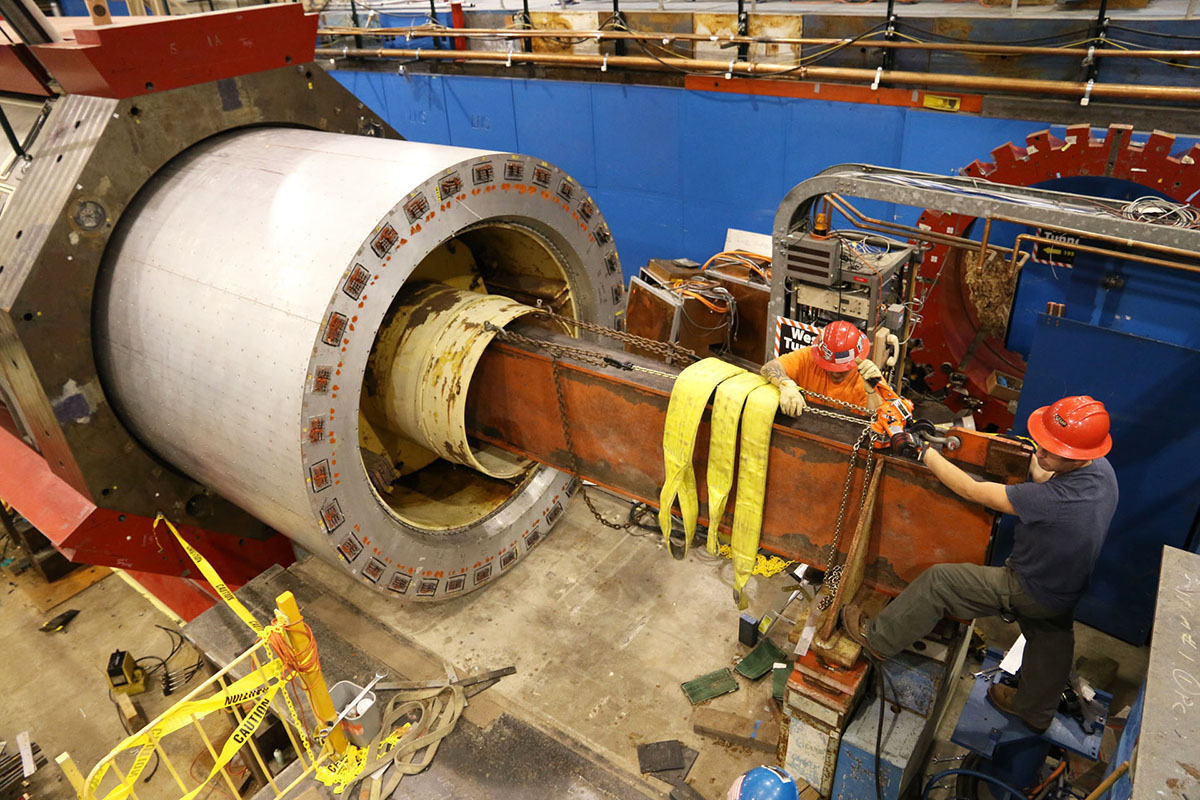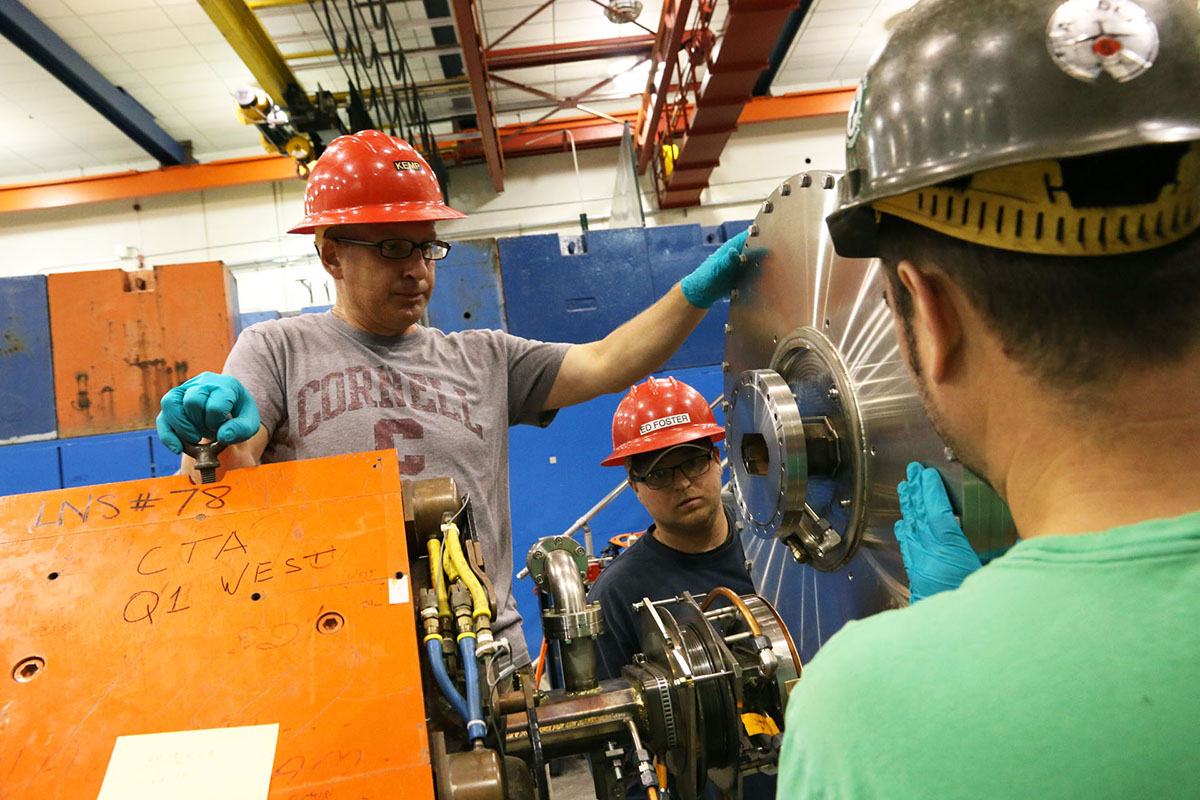With CLEO detector gone, CHESS facility looks back, ahead
By Tom Fleischman

Three months ago, without a whole lot of fanfare, an era in particle physics at Cornell came to an end.
On Sept. 6, the 26-ton solenoidal superconducting magnet was carefully removed from the Wilson Synchrotron Laboratory. This was the last vestige of the CLEO detector, which for nearly 30 years recorded data produced from the collision of positively and negatively charged electrons that hurtled around the 840-yard subterranean collider, CESR (Cornell Electron-positron Storage Ring).
The magnet has been sent to the Thomas Jefferson National Accelerator Facility in Newport News, Virginia, where in several years it will begin providing a magnetic field for a new experiment there. CLEO’s removal heralds a new direction for the Cornell High-Energy Synchrotron Source (CHESS), which soon will undergo a $15 million upgrade to enhance the quality of its X-ray beams.
With the removal of CLEO, the path is clear for the CHESS upgrade, after which the accelerator will operate with a single beam of positrons optimized for X-ray production instead of counter-rotating electron and positron beams. This will enable all CHESS beam lines to be aligned to a single beam orbit, enhancing the X-ray beam quality for research in physics, chemistry, biology, and environmental and materials sciences.
CLEO underwent numerous upgrades and produced a mountain of data from its completion in 1979 to its final run on March 3, 2008. The first CLEO paper listed 73 authors from eight institutions; the most authors on a paper produced there was 226.
“That was an incredibly productive time,” said James Alexander, physics professor and former director of the Laboratory of Elementary-Particle Physics. “We published more than 500 papers – in fact, in the few years after 2008, there were still papers coming out.” The total reached 530 peer-reviewed publications.

“In those days, we were way ahead of everybody,” said Alexander, who’s been at Cornell since 1988. “We published more papers than any other high-energy physics experiment. … everybody wanted to hear what CLEO’s latest results were.”
CLEO carried out a broad physics program of studying the production and decay of various matter particles (bottom and charm quarks, as well as tau leptons) and searching for new phenomena beyond the Standard Model of particle physics. It was cutting-edge stuff at Wilson Lab, a facility that had gotten used to breaking new ground over the course of a half-century.
Cornell’s involvement in nuclear physics began in 1934, when members of the physics faculty convinced M. Stanley Livingston to leave the world’s first cyclotron, which he helped build at Stanford University, to come to Ithaca and build the second.
The CLEO era began in 1979 and over the years included 42 institutions and more than 400 physicists from around the world. CLEO’s heyday was in the 1990s, due in large part to CESR’s status as the highest-luminosity collider in the world following a couple of major upgrades in the 1980s.
Also contributing was U.S. Congress’ decision to defund a large accelerator program in Texas.
“When that was killed off, there were a lot of high-energy physics groups across the country that had the rug pulled out from under them, and many of them joined CLEO,” Alexander said.
CLEO underwent five upgrades over the years, but by 2003, with new detectors springing up at Stanford and in Japan to do the same work as CLEO, “we saw the writing on the wall,” he said.
“We all sat back here thinking, ‘They don’t know how hard it is; it’ll take them far longer than they think; we’re going to remain king of the hill for a long time to come,’” he said. “It didn’t happen – when they both turned on, it was like a rocket.”
CLEO shifted its focus to lower-energy study of a different variety of quark, but in 2008 funding dried up, and CLEO – as well the Stanford program, called BaBar – shut off for good.

The process of removing the CLEO detector started in the spring, and was a difficult and delicate operation involving contributors from several departments.
“It’s been very nostalgic to see CLEO removed,” said senior physicist Brian Heltsley, who’s been at Cornell for more than 30 years. “And it’s been really impressive, with all the rigging needed to get these 30-ton hunks of metal out of the lab. I think it was an opportunity for our staff to shine; a place like this doesn’t run without electronics experts, riggers, all sorts of technicians at every level, and administrators.”
Heltsley said that intellectual standards over the years have been “unyieldingly high” at Wilson Lab.
“Over those years, habits become ingrained,” he said. “And that high standard of performance, of testing, of leaving nothing to chance … that permeates not only the academics but filters down all the way to every aspect of the lab. Supervisors, technicians, everyone: They will not accept a mediocre job.”
The pending upgrade will, among other things, configure CESR for single-beam X-ray operations and optimize the experiment stations for specific measurements. “This new project,” Heltsley said, “will continue that high standard of intellectual and technical sophistication.”
CHESS annually hosts more than 1,200 scientists and scientists-in-training. It is supported by the Division of Materials Research and the Directorates of Biology and Engineering of the National Science Foundation.
Media Contact
Get Cornell news delivered right to your inbox.
Subscribe